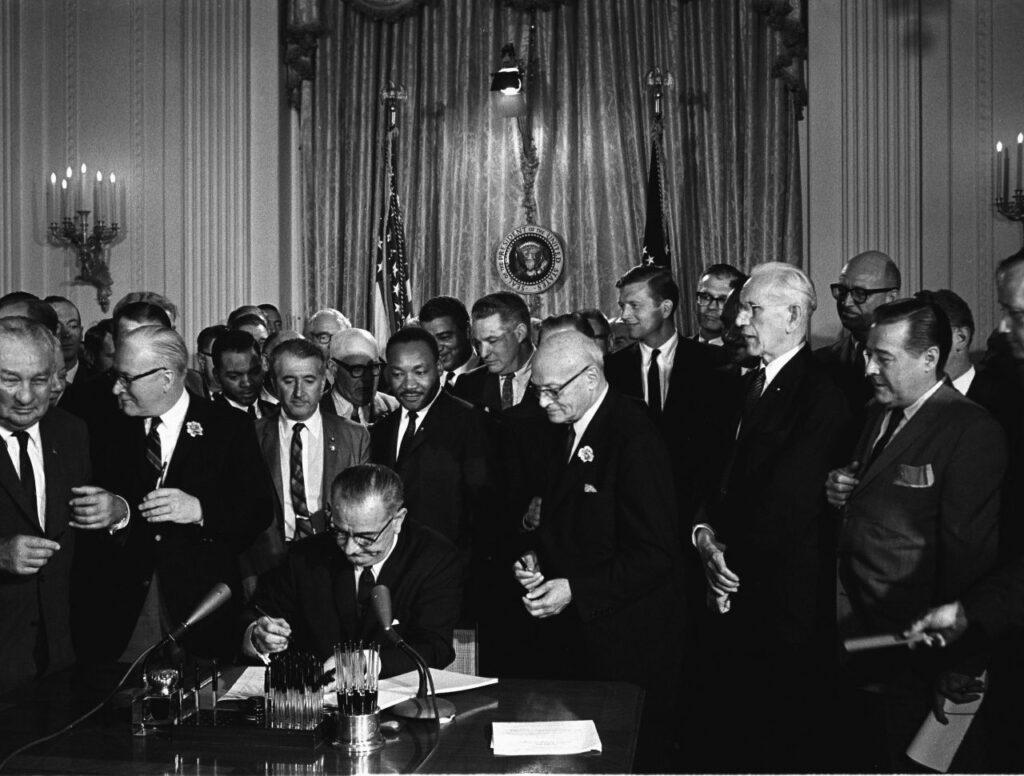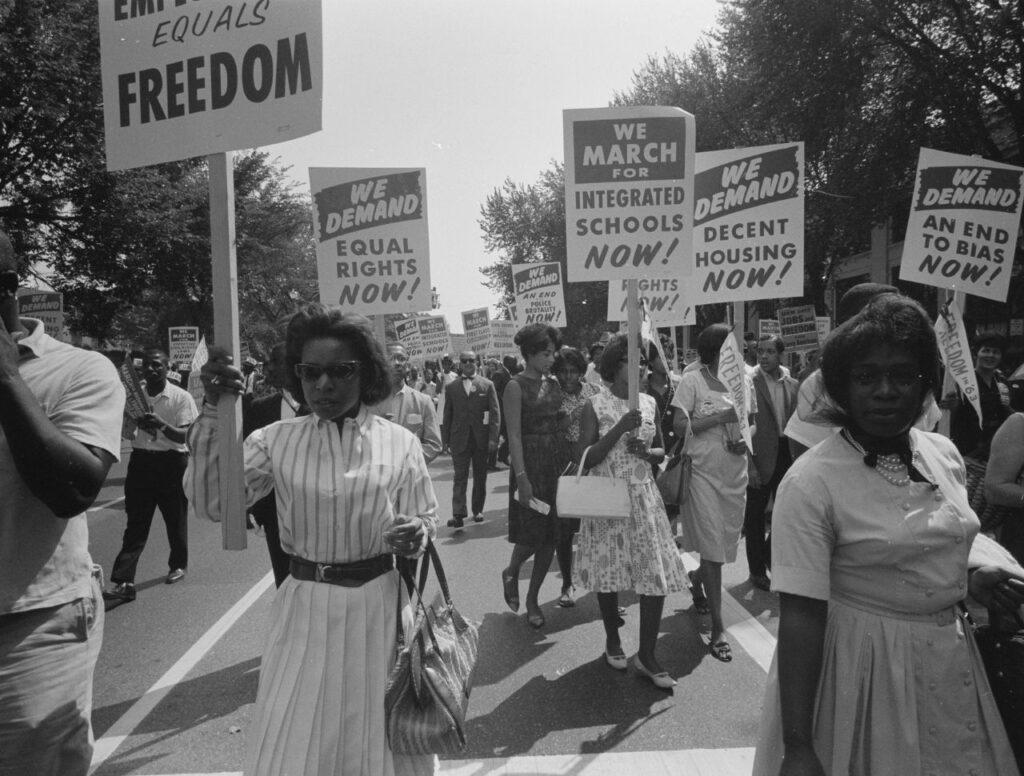Before 1964, many aspects of public life in America allowed discrimination based on race, color, religion, sex, or national origin. People’s identity could exclude them from voting, schooling, working, housing, transportation, or dining. This was the harsh reality for millions of Americans who suffered from oppression and injustice every day. This changed in 1964 when the Civil Rights Act of 1964 was enacted by Congress and the President, one of the most important and influential laws in American history. This article will explain the Civil Rights Act of 1964, its background, its effects, and its significance for America today.

What led to the passage of the Civil Rights Act of 1964?
The Civil Rights Act of 1964 was the result of years of struggle and activism by various groups and individuals who fought for equality and justice in America. The civil rights movement used various methods and tactics, such as boycotts, sit-ins, marches, lawsuits, and speeches, to demand their rights and dignity. Some of the key events and leaders of the civil rights movement include:
- The Montgomery Bus Boycott started when Rosa Parks refused to give up her seat to a white passenger on a segregated bus. The boycott lasted for over a year and ended with a court ruling that declared bus segregation illegal.
- The Little Rock Nine were nine African-American students who enrolled in an all-white high school. They faced violence and harassment from white mobs and state officials who tried to stop them from attending school. They were protected by federal troops who enforced school desegregation.
- The Greensboro Sit-In started when four African-American college students sat at a whites-only lunch counter. They were refused service but refused to leave. They were joined by hundreds of other students who staged similar sit-ins across the South. The sit-ins drew attention and pressure on businesses to end segregation.
- The Freedom Rides were organized by civil rights activists who rode buses across the South to test and challenge the laws that banned segregation in interstate transportation. They faced attacks and arrests from white supremacists and local authorities who opposed their efforts. The Freedom Rides exposed the violence and resistance of segregationists and forced the government to intervene and protect the riders.
- The March on Washington was a huge rally of more than 200,000 people who gathered in Washington, D.C., to demand civil rights legislation from Congress. The march featured speeches and performances by various civil rights leaders and celebrities, including Martin Luther King Jr., who gave his famous “I Have a Dream” speech.
- The Birmingham Campaign was a series of protests and demonstrations led by Martin Luther King Jr. in Birmingham, Alabama, a segregated and violent city. The campaign challenged racial discrimination and injustice in the city. The campaign faced violence and repression from local authorities. The campaign drew media attention and sympathy for the civil rights cause.
- The Assassination of John F. Kennedy, who was the President of the United States and a supporter of civil rights legislation. He was shot and killed by Lee Harvey Oswald in Dallas, Texas. His death shocked and saddened the nation and the world. His successor, Lyndon B. Johnson, vowed to honor his legacy by passing the Civil Rights Act of 1964.
What did the Civil Rights Act of 1964 do?
The Civil Rights Act of 1964 consisted of 11 titles or sections that addressed different aspects of discrimination and provided different remedies and enforcement mechanisms. Some of the main titles and provisions of the Civil Rights Act of 1964 are:
| Title | Main Points |
|---|---|
| Title I | – Gave the federal government the power to enforce the voting rights of African-American men. – Allowed the Attorney General to sue states or localities that denied or limited their voting rights. – Created the Civil Rights Commission, an agency that investigated and reported on voting discrimination. |
| Title II | – Banned discrimination in public accommodations, such as hotels, restaurants, theaters, and stadiums. – Required any business that served the public to serve all customers regardless of their race, color, religion, sex, or national origin. – Gave the Attorney General the power to sue or join lawsuits against violators. |
| Title III | – Banned discrimination in public facilities, such as parks, libraries, museums, and schools. – Required any facility owned or operated by a state or local government to be open and accessible to all people regardless of their race, color, religion, sex, or national origin. – Gave the Attorney General the power to sue or join lawsuits against violators. |
| Title IV | – Encouraged and authorized the desegregation of public schools. – Required any school district that received federal funds to comply with the court ruling that declared school segregation illegal. – Gave the Attorney General the power to sue school districts that maintained segregated schools and to help school districts that voluntarily desegregated their schools. |
| Title V | – Expanded and strengthened the Civil Rights Commission. – Increased its members, terms, scope, and functions. – Gave the commission the power to investigate and report on any civil rights issue, not just voting rights. – Gave the commission the power to issue subpoenas and hold hearings. |
| Title VI | – Prohibited discrimination in any program or activity that received federal funds. – Required no person to be excluded from participating in or benefiting from any federally funded program or activity based on race, color, religion, sex, or national origin. – Gave the federal agencies that administered such programs or activities the responsibility and authority to enforce this provision by cutting off funds from violators or by taking other actions. |
| Title VII | – Banned employment discrimination based on race, color, religion, sex, or national origin. – Covered employers, unions, agencies, and committees with 15 or more employees. – Prohibited any unfair practices, harassment, retaliation, or segregation in employment. – Created the EEOC, an agency that enforced this title and helped individuals sue violators. |
| Title VIII | – Established a Community Relations Service (CRS), an agency within the Department of Justice that provided mediation and conciliation services to communities that faced racial or ethnic conflicts or violence. – Aimed to prevent and resolve disputes and tensions between different groups of people by facilitating dialogue, cooperation, and understanding. |
| Title IX | – Intervened in cases involving jury discrimination. – Allowed any person who was indicted for a federal crime to challenge the composition of the grand jury or the petit jury that indicted or tried him or her on the grounds of racial or other discrimination. – Gave the Attorney General the power to sue states or localities that discriminated in jury selection or service. |
| Title X | – Established a Commission on Civil Rights within the District of Columbia. – Gave the commission the power to investigate and report on civil rights issues within the nation’s capital and to make recommendations for improvement. |
| Title XI | – Provided general provisions for enforcing and implementing the Civil Rights Act of 1964. – Stated that any person who violated any part of this act could be fined or imprisoned or both. – Stated that any person who interfered with another person’s exercise of his or her rights under this act could be fined or imprisoned or both. |
Consequences of the Civil Rights Act of 1964
The Civil Rights Act of 1964 changed the legal and social situation of America for different groups of people. It was a major turning point in civil rights and human rights history. It also caused many challenges and controversies that still affect the nation today. These are some of the consequences of the law:
- For African Americans, it ended legal segregation and discrimination and opened new opportunities and possibilities. It also inspired them to demand more rights and reforms and led to new leaders and movements.
- For women, it banned sex discrimination and gave them more access and protection. It also motivated them to seek more rights and changes and led to new organizations and groups.
- For immigrants, it prohibited national origin discrimination and set an example for other laws that promoted diversity and tolerance. It also influenced them to seek more rights and recognition and contributed to the growth and development of new communities and cultures.
- It banned discrimination based on race, color, religion, sex, or national origin and set a basis for other anti-discrimination laws. It motivated and helped them pursue more rights and changes and create and grow new groups and movements.
Challenges and Controversies:
- Opposition from segregationists resisted and rejected the law and used various tactics and strategies to prevent or delay its implementation and enforcement. They also formed or joined groups and parties to promote their views and interests.
- Rebellion from states and businesses, who defied or ignored the law and used various methods and arguments to challenge or evade its authority and validity. They also enacted or maintained laws or policies that contradicted or undermined its provisions or goals.
- Gaps and flaws in the law, which limited or weakened its scope or effectiveness. They included various exceptions or exemptions that allowed some forms of discrimination to continue or emerge. They also included various ambiguities or inconsistencies that created confusion or controversy.
- Ongoing problems of discrimination and inequality persisted or worsened despite the law and its enforcement. They included various forms of discrimination that were subtle or covert. They also included various forms of inequality that were structural or systemic.
The Civil Rights Act of 1964 was a landmark legislation that changed America by outlawing discrimination based on race, color, religion, sex, or national origin in various areas of public life. It was a result of decades of struggle and activism by various groups and individuals who fought for their rights and dignity. The Civil Rights Act of 1964 had a profound and lasting impact on the legal and social situation of America for different groups of people, such as African Americans, women, immigrants, and minorities. It also sparked a series of challenges and controversies that continue to shape and influence the nation today.
Also, Read: The United States Constitution






